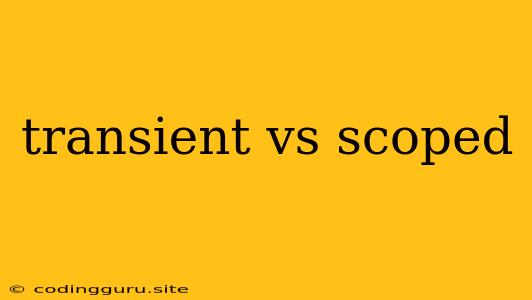Transient vs Scoped: Understanding Dependency Injection in Angular
Dependency injection is a core concept in Angular, facilitating modularity and reusability within your application. Two key scopes for injecting dependencies are transient and scoped, and understanding their differences is crucial for building robust and efficient Angular applications.
What is dependency injection?
Dependency injection (DI) is a design pattern that allows a component or service to receive its dependencies (other services, classes, or data) from an external source, rather than creating them internally. In Angular, this external source is the dependency injection framework.
The difference between transient and scoped:
Transient and scoped are two types of dependency injection providers in Angular, each affecting how instances of the injected dependency are created and managed within a specific context.
Transient:
- Instantiated for each injection: Every time a component or service requests a dependency with a transient provider, a new instance is created. This means that multiple injections of the same dependency will result in multiple separate instances.
- Suitable for stateless dependencies: If your dependency doesn't need to hold or manage any state, using a transient provider is a good choice. For instance, a service that performs simple calculations or data manipulation can be provided as transient.
Scoped:
- One instance per component/service: Unlike transient, scoped providers create a single instance of the dependency for a specific component or service. This instance is shared across all injections within that particular component or service.
- Suitable for stateful dependencies: If your dependency needs to maintain state, such as storing user preferences or tracking application-wide data, using a scoped provider is recommended. This ensures data consistency and avoids potential issues with state management.
Which one to choose?
The choice between transient and scoped depends on the specific requirements of your dependency and its role in your application.
Here's a breakdown of when to use each:
- Transient:
- Stateless dependencies: If the dependency is designed to perform actions without storing any internal state, transient is a suitable choice.
- Avoid unnecessary state management: Using transient can simplify your code and avoid potential issues with state synchronization when dealing with multiple instances of a dependency.
- Scoped:
- Stateful dependencies: If your dependency manages state or needs to persist information across multiple injections, scoped provides a single instance that guarantees data consistency.
- Component-specific state: If your dependency is closely tied to a specific component and its functionality, scoped ensures the dependency's state is confined to that component's lifecycle.
Example:
Consider a simple CounterService that increments a counter value:
import { Injectable } from '@angular/core';
@Injectable({
providedIn: 'root',
})
export class CounterService {
private count = 0;
increment(): number {
return ++this.count;
}
}
-
Transient: If you want each component using
CounterServiceto have its own independent counter, you would use a transient provider. -
Scoped: If you want all components using
CounterServiceto share the same counter, you would use a scoped provider within a parent component.
Conclusion:
Understanding the differences between transient and scoped providers is crucial for effectively managing dependencies in your Angular applications. By choosing the appropriate provider type, you can ensure efficient resource management, maintain data integrity, and optimize the performance of your application. Remember to consider the statefulness of your dependency and its role in the application context when selecting between transient and scoped providers.
